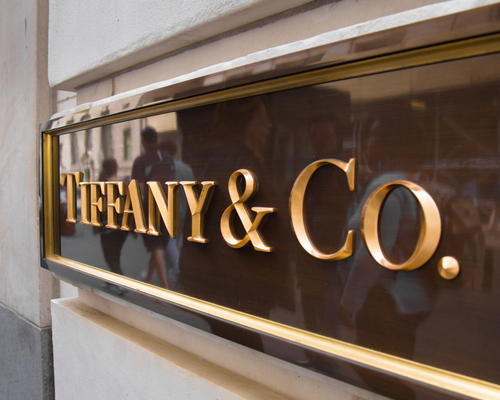To say that Tiffany & Co. has long been a staple of luxury jewelry is no exaggeration. Their name is synonymous with quality, beauty, and class, and with such a strong provenance it’s easy to see why this designer brand has maintained its highly sought-after status for centuries.
So let’s explore what sets this iconic brand apart from the rest and caused its continued popularity into the 21st century!

Founded in 1837 by jeweler Charles Lewis Tiffany and his business partner John B. Young in Brooklyn Connecticut, this future superstar had rather humble beginnings. Starting out as a stationary and fancy goods emporium, Tiffany & Co. (as it was branded soon after the establishment of the company) quickly moved to Lower Manhattan in 1838. By 1853, Charles Tiffany had succeeded in establishing the company’s emphasis on jewelry, shying away from its origins as a menagerie store full of luxury odds and ends.
In 1845, Tiffany & Co. released their first mail order catalog which became known as the “Blue Book.” While this mail order catalog may not seem like a huge deal, it was the first instance of Tiffany’s use of the iconic robin’s egg blue. Yes, that blue. This blue would later be patented and branded Tiffany Blue in 1998.
The scope of what Tiffany & Co. was capable of was drastically expanded during the Civil War from 1861 to 1865 when Tiffany & Co. supplied the Union Army with much needed swords, flags and surgical implements.
Only 5 years later, Tiffany & Co. was the first U.S. company to win an award for excellence in silverware at the Exposition Universelle in Paris, likely influenced by their refinement of silversmithing during the Civil War.
Memorably, in 1879 Tiffany purchased one of the world’s largest yellow diamonds, known as the Tiffany Diamond. The 128.54 carat cushion cut yellow diamond, set in a necklace with over 100 carats of white diamonds, is on display to this day in the Tiffany flagship store in New York City.
This incredible piece of history has only been worn by four women, first by E. Sheldon Whitehouse at the 1957 Tiffany Ball. The next star to wear this piece was Audrey Hepburn for the publicity photos for Breakfast at Tiffany’s in 1961, followed by Lady Gaga in 2019 for the 91st Academy Awards, and most recently by Beyoncé in 2021.
Now, we’re going to jump forward about a hundred years. Quite a bit happened during the early 1900s for Tiffany & Co., but the majority of this time was spent moving from building to building, and different companies purchasing Tiffany & Co. from each other.
One of the major acquisitions of Tiffany & Co. occurred in 1978 when Avon Products Inc. bought Tiffany & Co. Unfortunately, by 1984, customers began to complain about declining quality and service. During this time, Newsweek likened the quality of Tiffany’s items and prices to a Macy’s department store during a white sale, when an inexpensive product is marked down even more to get it out the door. This meant that cheaply made jewelry had been placed on sale en-masse. The overwhelming dissatisfaction with the declining service and product quality would eventually lead to Tiffany being sold again in 1984.
By 1990 a recession had swept the nation, and business was slowing for this iconic brand, just like many other luxury brands at the time. Tiffany jumped at the chance to have an image change, and rebranded as being attainable for everyone. They achieved this transformation by placing an emphasis on mass merchandising. They still created higher-end luxury jewelry, but this accessibility of their mass-produced jewelry allowed Tiffany to expand the reach of their brand within the public eye. These items, crafted mainly of sterling silver, were significantly less expensive than their one of a kind creations. During this time, they also marketed engagement rings starting at $850, a very affordable price point.
This next bit is more of a fun fact, but in 2001 Tiffany partnered with Pantone and standardized their Tiffany Blue color, renaming it “1837 Blue” after their founding year.
Since the 1990s, Tiffany & Co. has remained a renowned and sought-after brand for individuals of all walks of life. From the iconic “Please Return to Tiffany” tag bracelets to their innovations with gemstones, their stunning engagement rings and beyond, Tiffany has continued to dominate the affordable as well as the more exclusive designer jewelry trade.
The recent offerings of Tiffany & Co. include at least 11 active curated collections, some of which partner with the legendary designers Paloma Picasso, Jean Schlumberger and Elsa Peretti.
If you’ve ever found yourself wishing you could own a piece of jewelry from this brand with such a star-studded history, Leo Hamel Fine Jewelers is exactly what you need. Our extensive vintage Tiffany & Co. collection is authenticated, expertly refurbished, reasonably priced, and ready to come home with you today. You may even find discontinued and collectible pieces in our showcases. Call 619-299-1500, or come to our showroom at 1851 San Diego Avenue near Old Town to view our exquisite collection for yourself!



